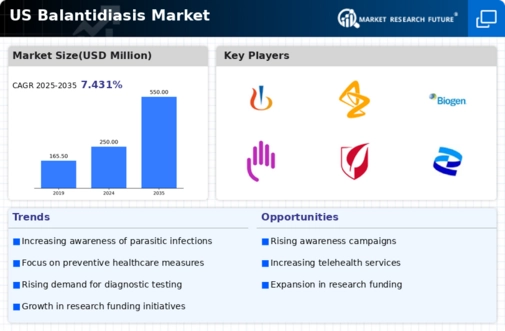The competitive landscape of the US Balantidiasis Market is shaped by several factors, including the prevalence of the disease, advancements in treatment options, and collaborative efforts among pharmaceutical companies and healthcare authorities to improve public health responses. Balantidiasis, caused by the Balantidium coli parasite, affects a segment of the population, particularly those with compromised immune systems, thus creating a niche but critical area for pharmaceutical companies to address. As awareness around parasitic infections grows, companies are focusing on research and development to bring targeted therapies to the forefront while navigating regulatory challenges and market competition.
The market is characterized by a blend of pharmaceutical giants with historical expertise in infectious diseases and emerging players exploring niche therapeutic developments.
Merck and Co stands out in the US Balantidiasis Market due to its significant experience in tackling infectious diseases. The company boasts a robust pipeline that includes research initiatives aimed specifically at parasitic infections, thereby enhancing its market presence. Merck's strength lies not only in its established therapeutic solutions but also in its extensive distribution networks and collaboration with healthcare institutions. This allows the company to efficiently deliver healthcare solutions to diverse patient populations, ensuring rapid access to necessary treatments.
Furthermore, Merck’s commitment to innovation and continuous improvement in drug formulations, alongside its proficiency in navigating the regulatory landscape, positions it as a formidable player in this market segment.
In the US Balantidiasis Market, Novartis pursues a strategic approach by focusing on the development of therapies that address both the treatment and preventive aspects of parasitic infections. The company has established a reputation for leveraging its research capabilities to innovate new treatment regimens tailored to patients suffering from Balantidiasis, along with key partnerships that enhance its market presence. Novartis possesses a comprehensive portfolio that includes a range of products aimed at infectious diseases, and it has made significant investments in research aimed at understanding and combating parasitic infections.
The company’s strengths are bolstered by its active engagement in mergers and acquisitions which have expanded its reach and capabilities in the health sector. This strategic expansion enables Novartis to consolidate its market position and embrace new therapeutic avenues while remaining committed to improving health outcomes for patients across the United States.











